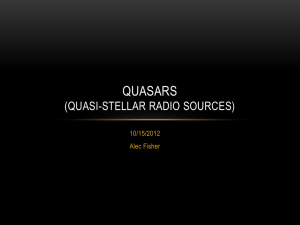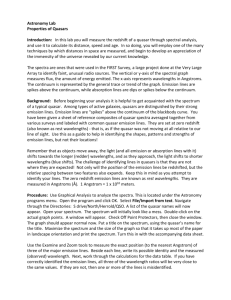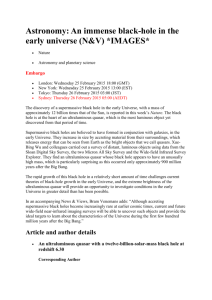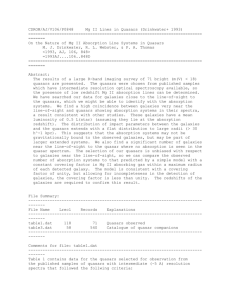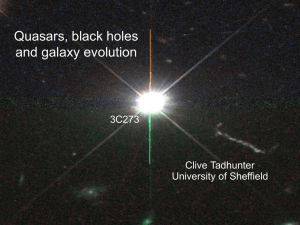docx - Simon P Driver
advertisement
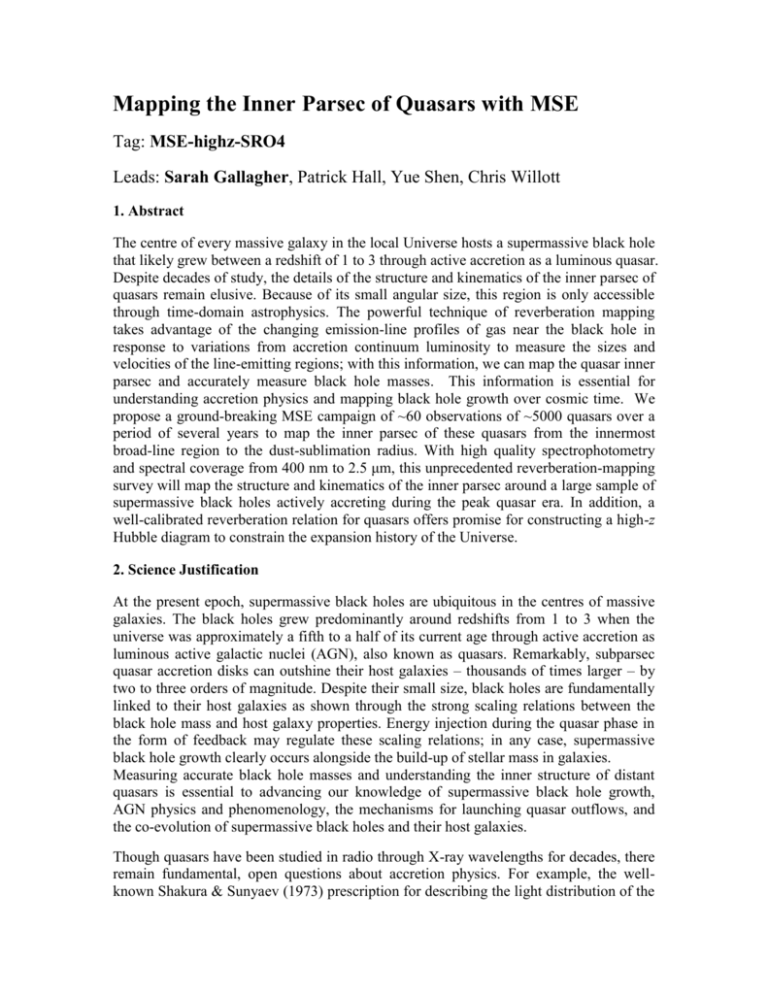
Mapping the Inner Parsec of Quasars with MSE Tag: MSE-highz-SRO4 Leads: Sarah Gallagher, Patrick Hall, Yue Shen, Chris Willott 1. Abstract The centre of every massive galaxy in the local Universe hosts a supermassive black hole that likely grew between a redshift of 1 to 3 through active accretion as a luminous quasar. Despite decades of study, the details of the structure and kinematics of the inner parsec of quasars remain elusive. Because of its small angular size, this region is only accessible through time-domain astrophysics. The powerful technique of reverberation mapping takes advantage of the changing emission-line profiles of gas near the black hole in response to variations from accretion continuum luminosity to measure the sizes and velocities of the line-emitting regions; with this information, we can map the quasar inner parsec and accurately measure black hole masses. This information is essential for understanding accretion physics and mapping black hole growth over cosmic time. We propose a ground-breaking MSE campaign of ~60 observations of ~5000 quasars over a period of several years to map the inner parsec of these quasars from the innermost broad-line region to the dust-sublimation radius. With high quality spectrophotometry and spectral coverage from 400 nm to 2.5 μm, this unprecedented reverberation-mapping survey will map the structure and kinematics of the inner parsec around a large sample of supermassive black holes actively accreting during the peak quasar era. In addition, a well-calibrated reverberation relation for quasars offers promise for constructing a high-z Hubble diagram to constrain the expansion history of the Universe. 2. Science Justification At the present epoch, supermassive black holes are ubiquitous in the centres of massive galaxies. The black holes grew predominantly around redshifts from 1 to 3 when the universe was approximately a fifth to a half of its current age through active accretion as luminous active galactic nuclei (AGN), also known as quasars. Remarkably, subparsec quasar accretion disks can outshine their host galaxies – thousands of times larger – by two to three orders of magnitude. Despite their small size, black holes are fundamentally linked to their host galaxies as shown through the strong scaling relations between the black hole mass and host galaxy properties. Energy injection during the quasar phase in the form of feedback may regulate these scaling relations; in any case, supermassive black hole growth clearly occurs alongside the build-up of stellar mass in galaxies. Measuring accurate black hole masses and understanding the inner structure of distant quasars is essential to advancing our knowledge of supermassive black hole growth, AGN physics and phenomenology, the mechanisms for launching quasar outflows, and the co-evolution of supermassive black holes and their host galaxies. Though quasars have been studied in radio through X-ray wavelengths for decades, there remain fundamental, open questions about accretion physics. For example, the wellknown Shakura & Sunyaev (1973) prescription for describing the light distribution of the UV-optical emitting region of accretion disks underestimates their sizes by factors of several (Blackburne et al. 2011; Jimenez-Vicente et al. 2012). The geometry and kinematics of the region generating the broad emission lines – the most prominent features of quasar optical-UV spectra – are still poorly constrained. These distant, cosmic powerhouses have such small angular sizes that they cannot be resolved with existing or near-term technologies; our only access to constraining their structure empirically is through time-domain astrophysics. In particular, we can use time resolution to substitute for angular resolution by measuring the rest-frame time lag of the response of a broad emission line to changes in the continuum illuminating the broad line region (Blandford & McKee 1982). The broad emission lines (with widths of 1000s km s−1) reveal the Doppler motions of dense gas close to the central black hole. Strong, broad, resonance lines are seen from ions with a large range of ionization states, from O VI to Mg II; the gas is photoionized with lowerionization gas at larger radii out to the dust-sublimation radius. The time lags represent light travel times from the continuum to the emitting region and can therefore be converted to physical length – a radius of the emitting region, Rline. Once Rline is measured, the mass of the black hole is approximately given by MBH = f(∆v)2Rline/G where G is the gravitational constant, ∆v is a measure of the width of the emission line, and f is a factor of order unity which accounts for the geometry and kinematics of the broad-line region (see, e.g., Peterson 2011, and references therein). For each quasar, the time lags and the continuum luminosities generate a radius-luminosity (Rline-Lcont) relation for each line, enabling the structure of the broad-line region to be mapped. With appropriate velocity resolution and time sampling, high-fidelity velocity-delay maps (line responsivity as a function of line-of-sight velocity and time delay; see Fig. 1) can be obtained with a reverberation-mapping (RM) campaign with a duration Tdur > 3τline, where τline is the time delay for a given line. Currently, only ∼50 local, low-luminosity AGN have high quality RM measurements of their Rline-Lcont relations and black hole masses (e.g., Bentz et al. 2009). The largest optical mapping campaign to date is the ongoing, 2 yr SDSS-BOSS program to monitor 849 i < 21.7 AGNs with the 2.5 m Apache Point Telescope in a single 7 deg−2 field (Shen et al. 2015). Dedicated time-intensive programs that monitor the rest-frame UV through optical of a handful of AGN are currently underway with e.g., HST COS (NGC 5548; PI Peterson) and the VLT X-Shooter (PI Denney). Though these programs will be foundational for taking the next step forward in RM science, MSE promises to go significantly further. Cosmological redshifting means that optical spectroscopic RM campaigns of quasars are fundamentally limited by a mismatch between the high quality data at low-z and what is accessible for high z. The lines sampled in these two regimes – e.g., Hβ and C IV for low and high z, respectively, arise from fundamentally different parts of the broad-line region, and there is significant scatter in the black hole masses derived from these two lines in single epoch spectra as a result of their distinct characteristics (Denney 2012). The major advantage of MSE over other planned RM programs (e.g., SDSS, OZDES, or 4MOST) is sensitivity (~2-3 mags deeper in 1 hr) because of the planned mirror size and the exquisite Mauna Kea site. The only planned instrument that would be competitive with MSE on these terms is Subaru-PFS; however, there are no current plans to invest the requisite time to a mapping campaign as outlined in this proposal. The inclusion of near-IR capability (to 1.8 or 2.5 m) to reverberation-map the rest-frame optical for high-z quasars would make MSE a game-changer in this field (see Fig. 2). There is no other planned facility with optical-NIR multiplexing of this scale. Ancillary Science: Though the demographics of the quasar population have changed remarkably since z~3, the structure of quasars shows surprisingly little evolution in fundamentals such as metallicity and spectral energy distribution. They are thus promising objects for constructing a high-z Hubble diagram given an appropriate independent estimate of luminosity such as a well-calibrated Rline-Lcont relation. The size of the line-emitting region can be measured from reverberation; this then yields the average quasar luminosity. From the measured flux and the redshift, a Hubble diagram to z~3 can be made from the proposed MSE high-z quasar reverberation-mapping campaign. Such a high-z Hubble diagram would provide important constraints on general cosmological models (King et al. 2014). Figure 1: Left: An image of a quasar accretion disk with a spiral density wave. Right: Time delay vs. velocity map for the Lyα (red), C IV (green), and He II (blue) emission lines. When the continuum emission from the accretion disk varies, the gas giving rise to the broad emission lines responds with a characteristic time delay. The spread of velocity components in each emission line is generated by different locations within the broad-line region, and therefore the line as a whole responds with a range of time delays. With appropriate time sampling, velocity resolution, and absolute flux measurements, the time delay-velocity map can be inverted to reconstruct the accretion disk image. (Image credit: K. Horne [star-www.st-andrews.ac.uk/astronomy/research/agn.php]) for Mauna Kea. For the peak of the quasar epoch (z = 1–3; bounded by horizontal lines) emission lines from CIV to Hα are accessible with wavelength coverage from 400 nm to 2.5 μm; at least one Balmer line will be at a wavelength of high atmospheric transparency. With wavelength coverage to 1.8 m, H is accessible for z<2.6. This range of lines probes size scales from the innermost broad-line region (of order light-days) to the dust sublimation radius (of order a few light years; Mor & Netzer 2012). Such broadband spectral coverage with the proposed time cadence would enable accurate black hole mass Figure 2: The location of broad emission lines of measurements for the largest sample of quasars to interest as a function of redshift overlaid on a date and unprecedented mapping of the central representative atmospheric transmission spectrum parsec. Bentz, M. C., et al. 2009, ApJ, 697, 160 Blackburne, J. A., Pooley, D., Rappaport,S., & Schechter, P. L. 2011, ApJ, 729, 34 Blandford, R. D. & McKee, C. F. 1982, ApJ, 255, 419 Denney, K. D. 2012, ApJ, 759, 44 Hopkins, P. F., Richards, G. T., & Hernquist, L. 2007, ApJ, 654, 731 Horne, K., et al. 2004, PASP, 116, 465 Jimenez-Vicente, J., et al. 2012, ApJ, 751, 106 King, A. L., et al. 2014, MNRAS, 441, 3454 Mor, R. & Netzer, H. 2012, MNRAS, 420, 526 Peterson, B. M. 2011, ArXiv1109.4181P Shakura, N. I. & Sunyaev, R. A. 1973, A&Ap, 24, 337 Shen, Y., et al. 2015, ApJS, 216, 4 Zu, Y., Kochanek, C. S., & Peterson, B. M. 2011, ApJ, 735, 80 3. Key astrophysical observables The essential requirements for a successful reverberation mapping campaign are to accurately measure the time lag between continuum variability and the response of each emission line, and to obtain a root-mean- square (RMS) spectrum of the quasar. The time-lags provide the size scale of the emission-line region, while the RMS spectrum shows the velocity structure of the material responding to the continuum variability. Both of these are required to map the structure of the broad-line region and to obtain accurate black-hole masses. The quality of these observables depends on the following parameters: • Accurate spectrophotometry: To detect low-amplitude, short-timescale continuum and emission-line variations requires high S/N spectra (S/N∼30 per resolution element at line center). Absolute flux calibration of the continuum is critical to detect flux variability at the 10% level. The current state-of-the-art is 6% with the SDSS-RM campaign; we require a minimum of 4% (as achieved with SDSS-I/II with 3” fibres). Systematic errors come from uncertainties in modeling standard star spectra, position-dependent atmospheric differential refraction, and pointing errors. Obtaining this goal may require allocating a larger fraction of standard star and sky fibres (200–500) than typical per field. • Sensitivity: We aim to achieve S/N~30 at i<24 in 1 hour integration times. Longer integration times compromise accurate spectrophotometry because of changing sky conditions. • Spectral resolution: Quasar broad-emission lines have typical widths of 1000s of km s−1. However, they are highly structured and often blended, and several resolution elements are required to adequately sample their velocity structure. Quasar narrow-emission lines have widths of 100s of km s−1 and would ideally be resolved in an individual spectrum. This sets the minimum resolution requirement of 200 km s−1 (R~1500) with 100 km s−1 (R~3000) being ideal. • Wavelength range: Continuous wavelength coverage in the regions of atmospheric transparency from 400 nm to 2.5 μm maximizes the science return on these timeintensive observations for quasars up to z~4 (Fig. 2). Simultaneous coverage of C IV and Hβ is necessary to map the broad-line region from the innermost regions to the dustsublimation radius. Furthermore, including rest-frame optical emission lines is essential for tying the typical high-redshift quasar to the extensively calibrated local reverberationmapped AGN. Cutting the wavelength reach on the red end to 1.8 m would reduce the redshift range with simultaneous CIV and H coverage to z=1.5-2.6, though this is likely a large fraction of the quasars up to z~3 within a flux-limited survey. Coverage limited to 1.3 m would effectively eliminate the link to low-z RM campaigns for the redshift range of interest, though a rest-frame UV RM campaign of this magnitude would still be ground-breaking (cf. Fig. 1). 4. Target selection Given the heroic efforts that have gone into building up large quasar samples with SDSS and follow-on surveys such as UKIDDS/DXS, several fields with known targets appropriate for the quasar variability program will be available prior to 2020. With sensitivity down to i = 24, the sky density of broad-line quasars is ~600 deg−2 (from the Hopkins et al. 2007 luminosity function). Therefore, for a 1.8 deg s−2 MSE field-of-view, we require 1000–1500 target fibres per pointing. The chosen field(s) should be within the LSST survey area to optimize the opportunity for improving spectrophotometric calibration and the increased time-sampling of continuum monitoring (a factor of 2 to 3; cf., Zu et al. 2011). If MSE is on-sky prior to LSST first-light, other facilities could be used for photometric monitoring. Our ideal sample size is ~5000 quasars (approximately 5 fields) to properly sample the diversity of the quasar population. 5. Cadence and temporal characteristics Repeat observations to measure continuum and emission-line variability are at the heart of our proposed science program. Quasar variability is a function of timescale (from days to years), luminosity (low luminosity quasars vary more), wavelength (quasars are more variable at shorter wavelengths and in higher ionization potential broad lines), and redshift (as a result of time dilation). For a given 6-month period of the SDSS-RM campaign, only ~10% of quasars are expected to have successfully measured lags (Shen et al. 2015); multiple seasons are therefore necessary to achieve the science goals. Horne et al. (2004) discuss the requirements for accurate reverberation mapping (RM). The peak emission-line time delay τ measured in a given RM campaign is the lightcrossing time of the broad-line region in that line at that time. The delay resolution is ∆τ ≃ 2∆t where ∆t is the sampling time interval. Therefore, to sample both short lags (days) and long lags (years), we envision a multi-year program with a cadence of several days in the first year, and reduced cadence in each successive year, totaling ≃60 epochs per field over 3–5 years. Given that this program would require less than one-third of the available fibres per pointing, it could naturally be executed concurrently with programs that (1) require repeat observations of very faint targets to build-up S/N in individual spectra, and/or (2) require extremely dense sampling of objects in an extragalactic field. Followup spectroscopy to identify interesting LSST transients could also be incorporated into the observing program. 6. Calibration Requirements • Wavelength calibration: As this program encompasses repeat and comparative observations of known targets, standard wavelength calibration should be sufficient. • Sky subtraction: The main sky features will need to be well-subtracted to enable accurate flux calibration. This may require an additional allocation of sky fibres to adequately sample the field-of-view. • Flux (spectrophotometric calibration): As mentioned in §3, the most stringent requirement for the success of the observing program is accurate spectrophotometry. The absolute flux of the continuum must be measured for the experiment. • Telluric absorption: Accurate telluric absorption correction is important for obtaining the high quality broad-band spectra needed for this program. For this reason, it may be desirable to allocate a larger number of sky fibres per pointing than in the typical survey program. • Other (e.g., stability): Absolute flux and wavelength calibration are the primary concerns. As long as they are sufficient, instrument stability is not the focus. 7. Data processing • Removal of instrumental signatures: Instrumental signatures must be removed from the spectra for the proposed analysis. • Measurement of astronomical quantities: For each quasar that varies sufficiently for reverberation mapping: (1) Available photometry, flux and wavelength-calibrated spectra from each epoch will be analyzed together to determine a Rline-Lcont relation for each broad line. (2) RMS spectra from each quasar will be constructed and analyzed to determine a black-hole mass. (3) For each quasar in the survey: A high S/N composite spectra will be constructed from the weighted average of individual spectra. These spectra will enable an unprecedented analysis of faint features in typical quasar spectra, such as weak forbidden lines and quasar host galaxy features. • Discussion of other data to be combined with MSE: High quality photometry (e.g., from LSST or other facilities) would be used to improve the spectrophotometry and increase the time cadence for continuum variability monitoring. Quasars in this sample with very high S/N spectra and well-measured black hole masses will be appealing targets for follow-up with other facilities, e.g., ALMA, TMT, and JWST. • Desired deliverables: The minimum deliverables would be flux-calibrated spectra for each epoch and combined, average spectra for all the quasars. Higher level products such as Rline-Lcont data for each broad line of successfully reverberation-mapped quasars would require additional time and resources to provide. 8. Any other issues None.
